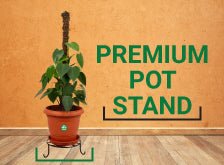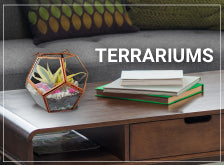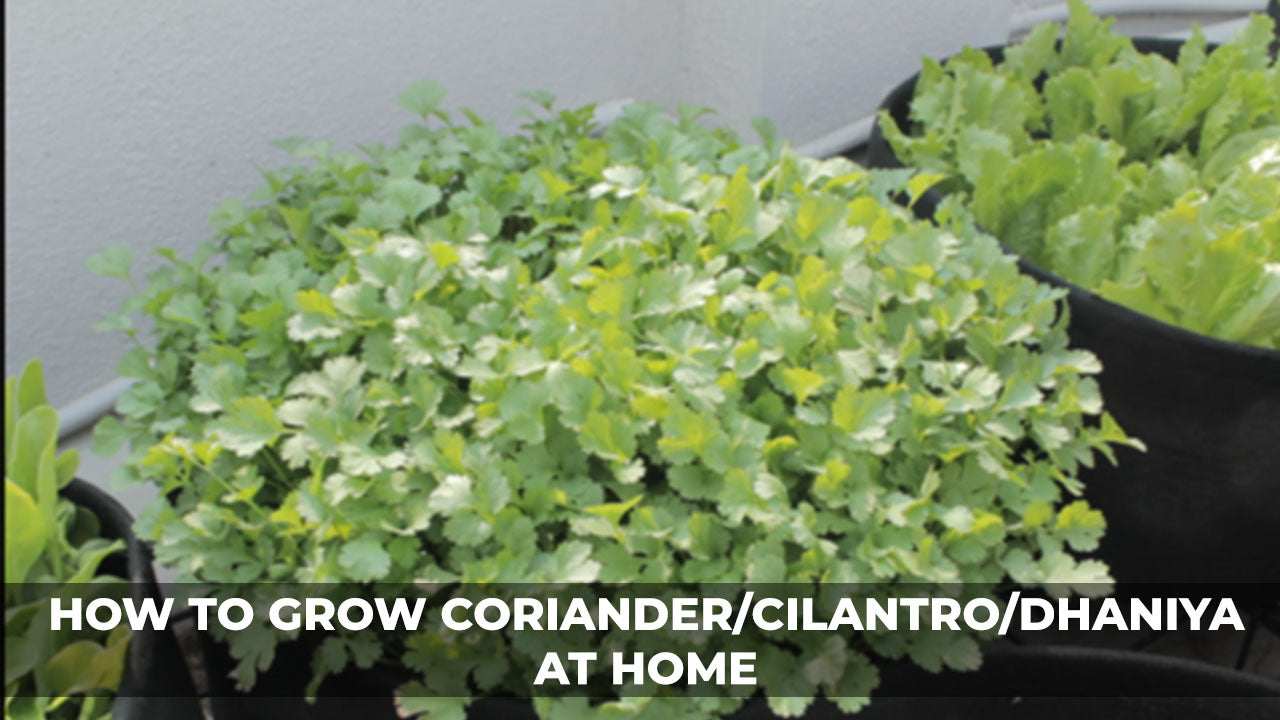How to Grow
Step-by-Step Guide on How to Grow Coriander Dhania at Home & its Health Benefits
Coriander is a herbaceous annual plant. There is no food which is prepared in the Indian culinary without coriander or cilantro. Their fresh leaves, stems and dry seeds are used as herbs and spices all over the world. Both leaves and stems of coriander have pungent flavor. Coriander grows within 40-45 days after sowing of seeds. Being spice and herb it is loaded with many health benefits from keeping your skin healthy to reducing risks of heart problems.

Botanical information
Botanical Name: Coriandrum sativum
Family: Apiaceae
Common names: Coriander, Cilantro, Dhaniya,
Centre of origin: Mediterranean region
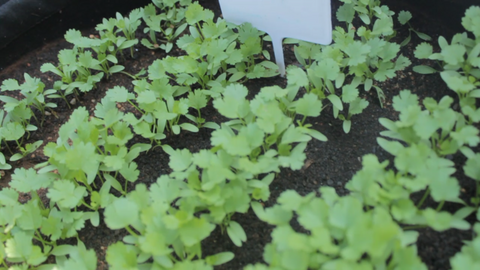
Essentials to grow coriander at home:
1. Soil: Select well drained fertile and less compact soil or potting mix to grow well. The soil pH can be from 6.5 - 7.0. Make sure the soil you use is organic and has no pathogens and weed seeds.

2. Location: Coriander can be grown in full sun to partial shade. Select well lit area with a minimum of 2-3 hours of direct sunlight. This lush green plant loves sunlight and can be sown under sun for producing good flavored leaves.
3. Seeds: Select good quality seeds from any trusted source. You can get open pollinated or hybrid seeds online from TrustBasket.


4. Water: Water them twice i.e. morning and evening consistently (during summer). Do not let the soil dry completely between watering
How to grow and care coriander at home:
- Take any pot/grow bag and add organic soil/potting mix for about 20-30 cm.
- It is always recommended to go for directing sowing instead of the transplanting method when it comes to coriander.
- Crush the coriander seeds to increase the chances of germination and germination rate. You can even use a chapati roller to gently crush the seeds.
- Either sprinkle seeds and cover them with a thin layer of soil or sow them in rows to make them look better.
-
Prefer to grow in rows to make the process of weeding and harvesting easy.


- Now water them until the entire growing media becomes wet. Maintain the soil moist until seeds germinate and establish well
-
watering should be done regularly until the seeds germinate. Because coriander seeds take around 2-3 weeks to germinate.




- Meanwhile, water them twice a day until they germinate and establish well.
- Discard the weak and poor seedlings.
- Water the seedlings carefully.
- Within 25-30 days after germination, coriander leaves reach maturity.
- Now, these fresh greens are all ready to go into your favorite dishes.
-
Cut the coriander stems at the soil level so that they regrow to offer you few more harvests.




How to grow coriander brought from store:
- Take healthy coriander stems that have roots.
- Cut the stems leaving 2 inches of stems above the origin of the roots.
- Plant these stems in any fertile organic potting mix at 3-4 inches apart.
-
Use well drained soil to plant coriander stems as clay soil retains water for long time and result in root rots.
image source
- Water them thoroughly after planting. Thereafter water them when the top inch of soil becomes slightly dry.
- Water plays a major role in keeping these coriander stems alive because it is the only source that allows them to intake nutrients. Leaving the soil dry between watering may damage the cutting as they do not have any leaves to supply food by performing photosynthesis.
- Stems may become dry but you will notice the new growth within 7-14 days of planting.
Bolting:
If you are growing plants for their leaves, bolting is surely a problem in them. The process of production of flowering stake earlier by any plant is known as bolting. When a plant starts producing flowering stake, it stops producing leafy biomass and the taste and flavor of leaves get deteriorated.
Bolting is a natural phenomenon that is adopted by plants to produce their off springs. The main reasons for bolting is to continue its generation, by entering into the reproductive stage when they are in stress. Bolting is good unless you grow plants for their leaves. The plants in which bolting is not appreciated are coriander, spinach, lettuce, and other leafy vegetables.
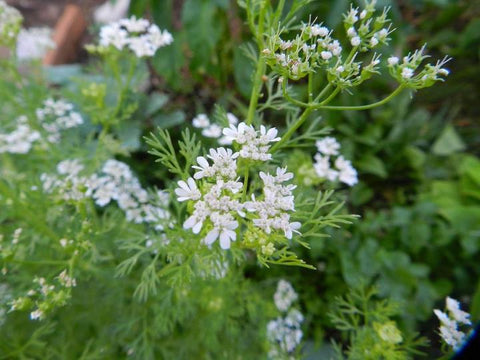
Reasons for bolting:
1. Heat: When plants receive too much of sunlight it forces plant to produce seeds earlier out of stress. So that they produce flowers and seeds to complete its life cycle.
2. Under watering: When you water your plants less than their requirement, it result in bolting in such plants.
3. Stress: Whenever plants feel stress due to any reason such as climatic factors, rootbounding, nutrient deficiencies etc. They tend to produce flowers.
How to grow coriander seeds:
When you grow coriander to harvest seeds, you need to wait some more days until the plants flower, set seeds. When the green seeds turn yellow- brown, you can harvest the seeds from them. It takes around 90-110 days from seeds to harvest. Meanwhile water them regularly and add any organic fertilizers for every 20 days right from flowering to harvesting. Fertilizing helps in boosting the flowering and seed setting in coriander plants. Follow these care tips if you intend to harvest coriander seeds.Common pests that damage coriander/cilantro and their damaging symptoms:
1. Indigo caterpillar:
It is velvety, black with yellowish to green stripes. When fully grown, it measures around 3.5 - 4.0 cm.
Damaging symptoms:
- They feed on coriander leaves making them pale and papery white.
- They make irregular holes and ultimately skeletonize the leaves leaving veins and petioles.
2. Aphids:
Aphids are the most common garden pests that come from nowhere. They infest the new growth and tender shoots. They mostly reside on the underside of leaves.
Damaging symptoms:
- Actively feeds on stems and leaves and result in curling and crinkling of leaves.
- Stunts the growth of plants.
3. Cutworms:
Common diseases to coriander leaves:
1. Powdery mildew:
It results in deformed leaves, premature sterility, and the absence of seed formation.
2. Damping-off:
It is caused by seed/soil borne fungus. Seedlings/plants wilt and collapse due to rotting at the ground level. It is often followed by root decay. Using healthy seeds and growing media that are free from pathogens is very important to prevent the plants from damping off.
3. Blight:
It is caused by bacteria and fungus and is associated with the appearance of dark brown spots on stems and leaves.
How to control pests and prevent coriander leaves from diseases:
Neem oil:
Use neem oil to get rid of common garden pests and diseases. Neem oil not only destroys pests but also keeps them away from your plants. It is an organic insecticide that is completely organic and acts as ovicide, larvicide, bactericide, and fungicide at the same time.
Dosage : 2 - 5 ml/litre.
Application: Prune the heavily infected/infested parts and spray neem oil once a week in the morning/evening times after watering the plants.

Coriander health benefits to your diet:
Coriander is a must added spice in Indian kitchens from the ancient times. There is no traditional dish that is prepared without adding cilantro in it. Coriander has wide range of uses due to its flavor and pungency. Apart from its ability to enhance taste and flavors, consuming coriander provides many health benefits. Here are few health benefits that we tried to list.

- Coriander may reduce bad cholesterol
- Coriander may reduce risks of heart problems.
- It has anti-inflammatory properties.
- May boost immune system.
- May reduce blood sugar levels.
- It promotes digestion and improves the gut health.
- Antioxidants present in it helps in improving the skin health.
Difference between coriander and cilantro:
| Coriander |
Cilantro |
|
Coriander comes from Coriandrum sativum |
Cilantro also comes from Coriandrum sativum |
| In US seeds are called coriander | Leaves and soft stems are called cilantro |
Click here to know how to grow lettuce from seeds.
Click here to know how to grow spinach from seeds.
Click here to know how to grow fenugreek/methi from seeds.
FAQs Related to Coriander Leaves:
1. Should I soak coriander seeds before sowing?
There are many ways to germinate & grow coriander seeds. You can sow them directly in soil without soaking or you can go for soaking over night. The main difference between them is when you sow seeds without soaking it takes more number of days to germinate, compared to soaked seeds. One more way is sowing of whole seeds or split seeds. Even here difference exists in number of days to germinate. Whole seeds take more days compared to split seeds.
2. How long does it take to grow coriander plants from seeds?
Coriander plants usually take 40 to 45 days to grow and reach harvesting stage. You can start harvesting cilantro or coriander leaves just from 35 days, depending on your purpose of use.
3. Is coriander easy to grow?
Yes, it is easy to grow coriander plants at your home. Because growing of these greens needs no special skills but few requirements like soil, seeds, light, manure and consistent watering to avoid bolting.
4. Can I grow coriander from store bought seeds?
Yes for sure, provided they are of good quality. But if you are beginner in gardening, you better go for purchasing seeds from authenticated sellers. Because the seeds bought from the store may not germinate some times. So instead of loosing motivation for growing plants you can start sowing with the good quality seeds.
5. What are common pests of coriander?
Usually leafy vegetables suffer from leaf minors, aphids, white flies and some times cut worms. For controlling all these sucking and cutting pests spray neem oil once a week as a prophylactic measure.
6. How to crush coriander seeds before sowing?
Drop the coriander seeds in any plastic bag. Place the bag on any table/surface. Take a chapati roller or any cylindrical object to crush the seeds. Place the object on the plastic bag that has seeds in it and roll it back and forth gently. By this coriander seeds get crushed slightly. Crushing seeds help in reducing the time of germination of the seeds.
7. Is it hard to grow coriander?
It is always very simple to grow leafy greens like coriander. The only thing that makes growing coriander difficult is, that they always dash to flower and set seeds to pass on to the next generation under stress. Bolting can mostly be avoided by not growing coriander herbs in summers.
Popular Searches: Garden Accessories for Sale, Compost Bin India, Plastic Flower Pots Online, Contemporary Plant Pots, Hanging Pots Online, Colourful Plant Pots, Bird Feeders Online, Rectangular Planters Online, Small Pots Online, Flower Pots Online, Kitchen Waste Compost Bin, Balcony Railing Planter, Buy Pots Online, Indoor Plant Pots, Metal Flower Pot

